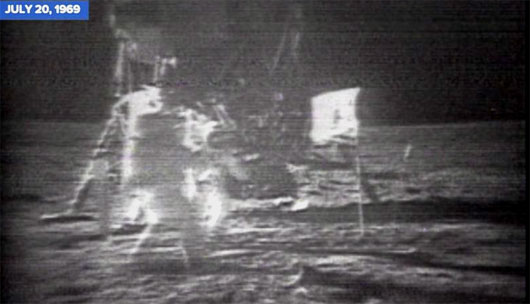Special to WorldTribune.com
Bondville, VT — For those of us of a certain age, we vividly remember where we were on July 20, 1969 the date of America’s successful Lunar landing.
On a cool July southern Vermont evening my parents and I visited friends to watch what was expected to be a live transmission from the Moon! So on a flickering black and white TV, they were able to pull in WBZ from Boston, and receive what even then we knew would be history.
America’s iconic space program was steeped in lore and legend but actually, in the beginning, had more to do with keeping up with the Soviets than actually exploring the huge frontiers of Outer Space.

We all know the story; the Soviets launched the Sputnik satellite which jolted American complacency and concentrated our attention on what later would be called the space race. By 1961, the Soviets had sent a man into space. In 1962 President John F. Kennedy pledged, “We choose to go to the Moon!”
Actually, his impulse was more political than scientific. A conversation, released by the John F. Kennedy Presidential Library reveals his true motivation to beat the Soviet Union; “In my opinion, to do it in this time or fashion, is because we hope to beat them,” he said, “and demonstrate that starting behind, as we did by a couple years, by God, we passed them.”
NASA became THE cutting edge and popular government agency if there ever was one. A whole generation was inspired by its vision the daring, and the human and technological achievements of the Space Program. Over 400,000 people worked in the program and NASA had an unquestioned budget of $25 billion, ($175 billion in today’s numbers!)
Think about it; from never having had an astronaut fly in outer space until 1961, a scientific program fast tracked an extraordinary mobilization which by 1969 operated multi-manned missions on the cusp of reaching and landing on the Moon.
For NASA, getting a man to the Moon was part of a long, arduous and dangerous series of space missions. In May 1961, Alan Shepherd, from New Hampshire, became the first American in Space. He was followed by John Glenn’s Mercury Mission in 1962 where he became the first man to orbit the earth.
The storied Apollo Missions were the stepping stones. The first step was a disaster; the terrible 1967 Apollo 1 launch pad ground accident which saw the deaths of three astronauts. Two lunar orbit and return missions preceded the Apollo 11 landing mission.
Part of the challenge was getting Astronauts to the Moon but also back safely.
Three astronauts were chosen for the Apollo Lunar 11 mission; Buzz Aldrin, Neil Armstrong and Michael Collins.
Interestingly and easily forgotten was Apollo 12, just months later in November of 1969 where astronauts again landed on the Lunar surface, this time in the Ocean of Storms region.
Then there was Apollo 13, the aborted and nearly disastrous mission in April 1970 and the subject of a thrilling movie. All told Apollo carried out four more successful landing missions until December 1972.
Over that period 12 American astronauts landed and walked on the Moon. The Apollo program had amazing ground support teams coordinated by NASA Flight Director Gene Krantz.
The Moon landing was the high point of a tumultuous summer where domestic discord over the Vietnam war tore apart the nation’s fabric. Casualties were mounting, the anti-war movement was seething, and the so-called Woodstock generation partied while American kids from Brooklyn, Biloxi and Baltimore were fighting and dying in the Mekong Delta.
So where do we go from here? Back to the Moon! During the Obama Administration, NASA suffered from neglect of manned space flight programs and actually outsourced some launches to Russia! Addressing the National Space Council, Vice President Mike Pence affirmed it’s now official policy to return American astronauts to the Moon by 2024, thus putting the U.S. back in the game.
Late that Sunday evening and amid lots of static and waiting which seemed forever before the astronauts left the Lunar capsule, there was the Main Event. Leaving the capsule, with the immortal words “This is One small step for Man, and One Giant Leap for Mankind,” Neil Armstrong and Buzz Aldrin were walking on the Moon!
Armstrong placed the American flag on the Lunar surface in what known as the Sea of Tranquility. A few people in our group, among then two New York City school Principals, proudly pointed at the little TV set and kept saying “That’s our Flag, That’s an American flag!” We walked home under the starry Vermont sky, and yes, winked at the Moon.
John J. Metzler is a United Nations correspondent covering diplomatic and defense issues. He is the author of Divided Dynamism the Diplomacy of Separated Nations: Germany, Korea, China (2014). [See pre-2011 Archives]

 By
By